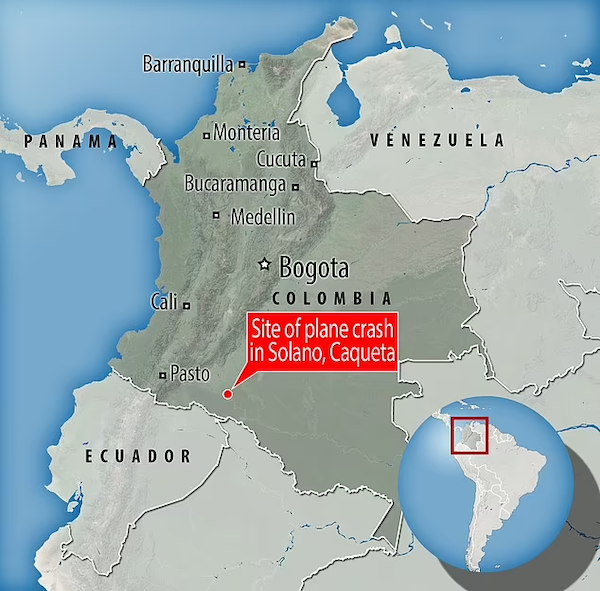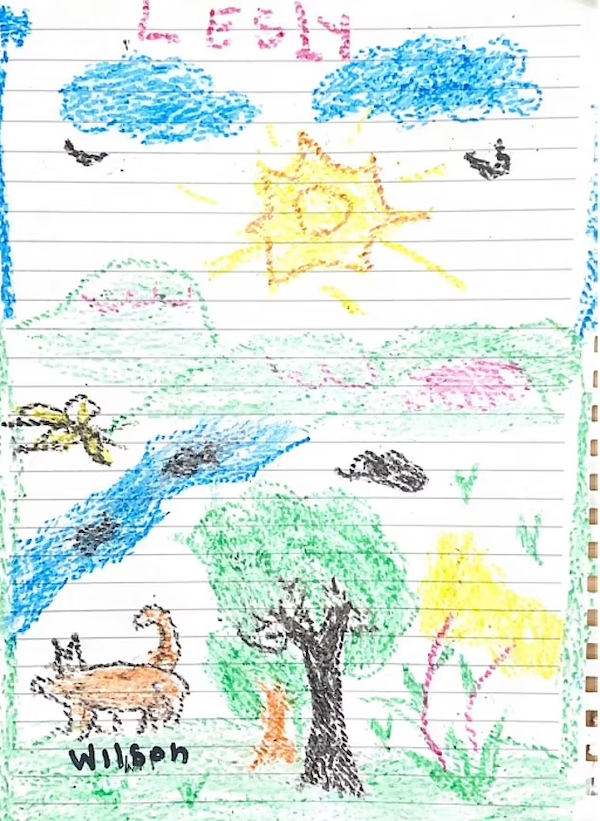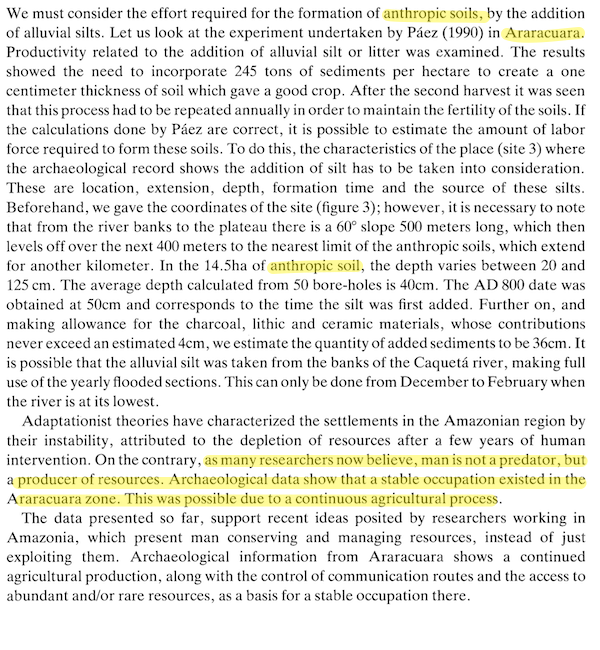By Lambert Strether of Corrente.
The story of how four Huitoto children survived for 40 days in Colombia’s Amazon jungle after their small plane crashed on May 1 after leaving their home village of Araracuara is heartening (if not entirely heartwarming; see Appendix). In this post, I’ll first outline the timeline as presented in the press; then I will look at accounts of how the children survived, and especially the fruits they ate; then finally at the question of why those fruits were there for them to eat in the first place (a question that goes unasked in all the coverage I could find). Here is the location of the plane crash, far from anywhere:

And here is the plane after the crash. As you can see, the jungle is dense:

(The children, who were accompanied by several adults who did not survive, were traveling in a small plane because there was no alternative: no roads, no rivers.) And here are the children, rescued, in hospital[1]:
The four little children who miraculously managed to survive 40 days in the Colombian Amazon Rainforest on their own.
Lesly (13), Soleiny (9), Tien Noriel (4), and baby Cristin (1), safe in their hospital beds at a military hospital in Bogota. https://t.co/2jZOkrMtxl pic.twitter.com/9ZXg8GbyRu
— Bobbie☀️ (@bo66ie29) June 13, 2023
NPR gives a good timeline for the crash and subsequent events:
Four Indigenous children survived an Amazon plane crash that killed three adults and then wandered on their own in the jungle for 40 days before being found alive by Colombian soldiers.
The group of four children were travelling with their mother from the Amazonian village of Araracuara to San Jose del Guaviare when the plane crashed.
The crash happened in the early hours of May 1, when the Cessna single-engine propeller plane with six passengers and a pilot declared an emergency due to an engine failure.
Officials did not say how far the children were from the crash site when they were found. But the teams had been searching within a 4.5-kilometer (nearly 3-mile) radius from the site where the small plane nosedived into the forest floor.
As the search progressed, soldiers found small clues in the jungle that led them to believe the children were still living, including a pair of footprints, a baby bottle, diapers and pieces of fruit that looked like it had been bitten by humans.
But [President Gustavo Petro] added that the children were first found by one of the rescue dogs that soldiers took into the jungle.
An air force video showed a helicopter using lines to pull the youngsters up because it couldn’t land in the dense rainforest where they were found.
No details were released on how the four siblings aged 13, 9, 4 and 11 months managed to survive on their own for so long, though they belong to an Indigenous group that lives in the remote region.
The Guardian gives more detail on the rescue operation:
The rescue effort, Operation Hope, ramped up rapidly, eventually encompassing 150 soldiers and 200 volunteers from local Indigenous communities and a team of 10 Belgian shepherd dogs, covering an area of more than 323 sq km (125 sq miles). The search continues for Wilson, one of the dogs who disappeared during the operation.
But what did the four children eat during their 40 days? (The Army is said to have airdropped food packages in the general area where they thought they children were to be found, but there’s no indication that the children found any of them.) Here the coverage is consistent:
Cassava flour and some familiarity with the rainforest’s fruits were key to the children’s extraordinary survival in an area where snakes, mosquitoes and other animals abound.
“When the plane crashed, they took out (of the wreckage) a fariña, and with that, they survived,” the children’s uncle, Fidencio Valencia told reporters outside the hospital. Fariña is a cassava flour that people eat in the Amazon region.
Timing was in the children’s favor. Astrid Cáceres, head of the Colombian Institute of Family Welfare, said the youngsters were also able to eat fruit because “the jungle was in harvest.”
BBC:
The children’s grandmother, Fatima Valencia, said [that their mother, before she died], “gave them flour and cassava bread, any fruit in the bush, they know what they must consume.”
Leaders from the Huitoto indigenous group expressed hope that the children’s knowledge of fruits and jungle survival skills should give them better odds of being found alive.
And we have two pieces of evidence the children ate fruit, perhaps after the cassava ran out. First, toothmarks:
As the search progressed, soldiers found small clues that led them to believe the children were still alive, including a pair of footprints, a baby bottle, diapers and pieces of fruit that looked like they had been bitten by humans.
Second, we have (speculative) evidence from the children themselves. Here is the picture that Lesly drew of Wilson the sniffer dog (now being searched for himself), who was the first living being to find them:

You can tell me I’m reaching here — I certainly do have priors, which we’ll get to — but what I notice about Lesly’s picture is the trees: They are not all brown trunks and green leaves, like the trees I certainly drew as a child; Lesly’s trees have trunks and leaves in different colors, and I’d speculate that’s because they bear different kinds of fruit[2]. In other words, the drawing describes or rather inscribes “indigenous knowledge.” From The Conversation:
Even before starting elementary school, children in this area accompany their parents and elder relatives in various activities such as gardening, fishing, navigating rivers, hunting and gathering honey and wild fruits. In this way the children acquire practical skills and knowledge, such as those demonstrated by Lesly, Soleiny, Tien and Cristin during their 40-day ordeal.
Indigenous children typically learn from an early age how to open paths through dense vegetation, how to tell edible from non-edible fruits. They know how to find potable water, build rain shelters and set animal traps. They can identify animal footprints and scents – and avoid predators such as jaguars and snakes lurking in the woods.
The children would also have learned from their parents and elders about edible plans and flowers – where they can be found. And also the interrelationship between plants, so that where a certain tree is, you can find mushrooms, or small animals that can be trapped and eaten.
So now we have the timeline straight in our minds, we know the children survived on fruit, and we know they understood how to recognize fruit that was safe to eat.
But why was there fruit there to eat in the first place?
Here is where my priors kick in. When I heard “Amazon,” I at once thought of Amazonia, championed by Charles C. Mann in his great 1491 (oft mentioned, but never reviewed, sadly, at NC). Quoting from 1491, from p. 306 forward:
According to Charles R. Clement, anthropological botanist at the Brazilian National Institute for Amazon Research (INPA) in Manaus [the approach of the first Amazonians was not] to clear the forest but to replace it with one adapted to human use. They set up shop on the bluffs that mark the edge of high water — close enough to the river to fish, far enough to avoid the flood. And then, rather than centering their agriculture on annual crops, they focused on the Amazon’s wildly diverse assortment of trees. …
Of the 138 known domesticated plant species in the Amazon, more than half are trees. (Depending on the definition of “domesticated,” the figure could be as high as 80%.) Sapodilla, calabash, and tucumai; babacu, acai, and wild pineapple; cocopalm, American-oil palm, and Panama-hat palm — the Amazon’s wealth of fruits, nuts, and palms is justly celebrated. “Visitors are always amazed that you can walk in the forest here and constantly pick fruit from trees,” Clement said. “That’s because people planted them. They’re walking through old orchards.”
Exactly what our children did: Pick fruit. And everyone else is amazed! More:
Planting their orchards for millenia, the first Amazonians slowly transformed large swaths of the river basin into something more pleasing to human beings. In the country inhabited by the Ka’apor, on the mainland south of Marajo, centuries of tinkering have profoundly changed the forest community. In Ka’apor-managed forests, according the Balée’s plant inventories, almost half of the ecologically important species are those used by humans for food. In similar forests that have not recently been managed, the figure is only 20 percent. Balée cautiously estimated, in a widely cited article published in 1989, that at least 11.8 percent, about an eighth, of the non-flooded Amazon was “anthropogenic” — directly or indirectly created by humans. [Clark Erickson of the University of Pennsylvania] told me in Bolivia that the low-land tropical forests of South America are among the finest works of art on the planet.
The name of this great work of art is Amazonia. Amazonia has a distinctive feature: Its soil. From Charles Mann in The Atlantic:
In the late 1990s Woods and others began careful measurements in the lower Amazon. They indeed found lots of inhospitable terrain. But they also discovered swaths of terra preta—rich, fertile “black earth” that anthropologists increasingly believe was created by human beings.
Terra preta, Woods guesses, covers at least 10 percent of Amazonia, an area the size of France. It has amazing properties, he says. … [T]erra preta is generated by a special suite of microorganisms that resists depletion. “Apparently,” Woods and the Wisconsin geographer Joseph M. McCann argued in a presentation last summer, “at some threshold level … dark earth attains the capacity to perpetuate—even regenerate itself—thus behaving more like a living ‘super’-organism than an inert material.”
In as yet unpublished research the archaeologists Eduardo Neves, of the University of São Paulo; Michael Heckenberger, of the University of Florida; and their colleagues examined terra preta in the upper Xingu, a huge southern tributary of the Amazon. Not all Xingu cultures left behind this living earth, they discovered. But the ones that did generated it rapidly—suggesting to Woods that terra preta was created deliberately. In a process reminiscent of dropping microorganism-rich starter into plain dough to create sourdough bread, Amazonian peoples, he believes, inoculated bad soil with a transforming bacterial charge. Not every group of Indians there did this, but quite a few did, and over an extended period of time.
When Woods told me this, I was so amazed that I almost dropped the phone. I ceased to be articulate for a moment and said things like “wow” and “gosh.” Woods chuckled at my reaction, probably because he understood what was passing through my mind. Faced with an ecological problem, I was thinking, the Indians fixed it. They were in the process of terraforming the Amazon when Columbus showed up and ruined everything.
(Columbus, Colombia [sigh].) But is in fact the children’s province part of Amazonia? Were the children indeed eating the fruits of Amazonia? I don’t have ironclad proof. However, I did search on “terra preta” (the distinctive soil of Amazonia) and Araracuara (the children’s village, or possibly region), and came up with this article: “The Technical Transformation of an Agricultural System in the Colombian Amazon” (from 1992, over a decade before 1491 was published, in 2005). “Anthropic soils” in Araracuara:

More:

Now, I freely admit that although terra preta is anthropic soil, not all anthropic soil is terra preta. Nor do I know the species of fruit the children ate. And although Araracuara is part of Amazonia, I don’t know that it is part of Amazonia as understood by Charles Mann (and his sources).
Nevertheless, my story is that the children’s lives were saved by ancient horticulturalists planting fruit trees five centuries ago, in what we would call today an edible forest[3]. And I’m sticking to it.
If you are concerned with the approach of The Jackpot, and you want to do something constructive at the individual scale, I would suggest that you consider planting trees with edible fruits or nuts, either collectively as part of an edible forest project, or on property available to you, if you have it, or even, guerrilla fashion, by the side of the road. Perhaps, one day, your own children will need to eat. And the creators of the world’s greatest work of art didn’t have the Internet, or cellphones, or automobiles, or any modern amenities at all. All they needed were seeds. And knowledge, of course.
NOTES
[1] Not a “miracle”, ffs. Start with Lesly’s level-headed-ness, and go on to the training they received as Huitoto members. And of course the sniffer dogs and the Army helped.
[2] Worth noting also: There’s nothing in Lesly’s picture about cassava, and nothing about airdropped food; this suggests that fruit was indeed their main food source.
[3] For edible forests at NC, see here, here, here, here, here, and here.
APPENDIX
The family was said to be fleeing “an armed group” in the plane. And a custody battle has broken out over the children.


Great post, Thanks! And yes, plant a tree. Our little yard’s pretty much an orchard at this point.
Makes good sense. Thank for the posting. Yes, we all need to grow food forests AND make biochar! (We successfully meet our veg and fruit needs after planting a food forest 20 years ago).
Wonderful article, Lambert on a wonderful topic. Thanks.
So humans and the Earth CAN work together? Humans can find a niche in an ecosystem rather than destroy it? Who knew? Well, I guess the species did manage to get to this point somehow.
It would seem that humans don’t inherently have to degrade and exploit everything around them. Who would we rather be as humans? Part of the tribe of Tech billionaires, building towers, transfusing the blood of 18 year-olds into themselves, plotting to leave the planet? Or part of a tribe that tends the garden, teaches its children the mysteries and beauties of their natural homes and walks noiselessly through jungle or forest or desert?
These children and their families can teach us how to get back to the garden.
There are modern “arboreal edible enablers” too. I remember living in Hialeah as a kid and finding edible carob pods on trees planted along the edge of the school yard. This was a deliberate planting. The trees were in a row and all about the same age. Watch out for the thorns! Those bean pods were sweet and chocolate flavoured. We were told by a teacher that those tree/shrubs had been planted by some nuns to supply free snacks for the kids during the day.
Even urban landscapes can be purposed for diet and delectation.
If you are a caffeine addict, the southern growing Yaupon holly is your friend. The bright red beans have the highest caffeine concentration known. And let us not forget chicory. I still enjoy the occasional coffee and chicory blend beverage.
Be safe, and well fed.
Nuns and Carob aka St. John’s Bread! Nice. And for some Christians St. Johns tide is celebrated on the 24th.
Phyl is Old School American Catholic. I’ll tell her that and she’ll probably give it a whirl in the kitchen. (I’ll volunteer as Quality Control.)
Stay safe.
I’ve been drinking only New Orleans blend coffee and chicory for the past 40 years. I like strong coffee and chicory is the only way to get it really strong without being bitter.
Stay safe.
Thanks, Lambert, for a thought-provoking excursion off the beaten path.
Colombia’s military does not have the best human rights record – the armed group the family was fleeing was quite possibly the Colombian military or one of the death squads it is allied with. Which would be ironic given all the good press that the Colombian military is getting out of this story.
Sorry to be so cynical but I have been to Venezuela and I have been to Colombia … Venezuela (when I was there) was definitely a democracy and Colombia was definitely not.
Great post, Lambert! How little we’ve learned from the ‘Green Revolution’ :-(.
I saw a doco on the early Amazonian civilization and it was fascinating, especially in how they formed Terra Preta. With the development of how to properly make it perfected, it went on to become a virtuous circle I am supposing. The more of this dirt, the larger the population that could be supported. The larger the population, the more people available to form more Terra Preta. And so on. As there were ‘ highways’ between the major settlements, I am guessing that they would set up one in the jungle in a direct line and then start to terraform the land around that settlement, especially the are between the old and the new settlement. Went looking for that doco on YouTube but what I found instead was that Joe Rogan had on a guest once that talked about this region. The episode is called “Graham Hancock – Lost Civilizations in Amazon & Terra Preta”-
https://www.youtube.com/watch?v=-z9ssM6F6CY (5:34 mins)
By the way, it may be that development of the Amazon is uncovering this civilization but the real work is being done by LIDAR. Here is one example-
https://www.youtube.com/watch?v=IAzS59FqKjc (8:22 mins)
> I saw a doco on the early Amazonian civilization and it was fascinating, especially in how they formed Terra Preta. With the development of how to properly make it perfected, it went on to become a virtuous circle I am supposing.
At some point no doubt somebody will conceptualize terra preta as an ecosystem service. Then we can have startups to make it. Which would be bad, because soil cannot be priced.
“…because soil cannot be priced.”
Oh my. Here we have a case for a Neo-liberal Rule #3: “Everything has a price.” {As distinguished from ‘value.’}
Stay safe, keep the Wheels of Commerce turning.
I think ‘Everything has a price’ is better understood as a corollary of Rule 1, ‘Because markets’.
Any terra preta pricers-and-sellers cannot stop other people who understand terra preta culturing and growing from giving that knowledge away for free to whatever interested people they can reach.
Such people can undermine the ecosystem-service for-a-price model, at least around the edges.
The other lesson is that it was hard work creating these soils and plantings and setting them into motion, and it was/is/will be steady work maintaining them and guiding them forward through time.
The wannabe food-forest-haver who would like a food forest or food grove or food glade or whatever, will have to decide how much hateful work he/she can tolerate through gritted teeth, and figure out how much food-habitat can be created and maintained through most efficient and effective targetting of that unavoidable work and then settle for having just that much food habitat around him/her.
No land-food without land-work. Sorry about that.
i was already pretty zoned out when this posted…but thanks!
sent this and the linked other NC posts on the subject…and the pdf where the seven layer model comes from…to my eldest son, who the other evening pretty much blurted that he guesses he needs to bone up on what i’m trying to do out here, re:permaculture/regenerative ag/and so on…because he’s realising that he’ll be in charge of it when i’m either gone or too old and decrepit.
my mom ruined his taste for gardening with her insistence on neat rows in weedless plots…he’s only noticed this year whats actually going on on our side of the place: what looks like riotous weeds are actually cover crops, and tactically allowed weeds to hide food plants from grasshoppers, chickens, etc…and that, if you know what youre looking for, our side of the place is actually producing orders of magnitude more…without touching a hoe.
and once the infrastructure is complete(arggh!), we’ll have a complete system of food, fiber, oil and fodder producing, without a whole lot of arduous labor.
he may have gotten the bug when he welded together the charcoal retort…and listened to me hold forth about tierra prieta…because there’s been more and more questions since then.
Fascinating, Lambert.
The area of Alabama just below the center of the state stretching from Mississippi into Georgia is called the Black Belt, and not for the majority of the residents who are extremely poor blacks. It’s called that for the deep, black soil that can grow almost anything that can tolerate the heat. I don’t know if it’s terra preta exactly, but it sure is prolific. I do know that it has plenty of alluvial sediment as in prehistoric times there was a huge river system that drained about 1/3 of the country through the Mobile Bay area.
I took your advice about edible forests a few years ago and now have blackberries, blueberries, loquats, and pears, although this year’s crops were kinda pitiful.
My daughter also decided to grow her own. She’s got some fruit trees and a 150 s.f. vegetable garden, including spices. She also raises ducks for eggs.
Of the hundred million( just a guess) or so suburban house-and-yard parcels existing in the US, what if 50 million of them have big enough yards to grow some food-habitat on? That could add up to a lot of food being grown outside the MSFS ( Main Stream Food System ). Such unpriced food grown with actual work could be thought of as part of Food System D. And the people practicing it successfully would free up some of the money they would otherwise have to spend on MSFS food for spending on higher priced higher quality artisanal food, which would keep artisanal food growers growing bio-viable food on bio-viable land in the teeth of the MSFS pressure to give up on artisanal food growing.
50 million food-habitat suburbistanis could help drive an Artisandustrial Food Reaction forward.
” Back to the Future. Forward to the Past.”
Question: how to plant peach/apricot pits so they grow? Does anyone here have any specific actionable advice?
The seeds grow easily, however you will most likely not get the apricot to ate, you will have to graft the variety you want onto the seed that you grew, which becomes the root stock